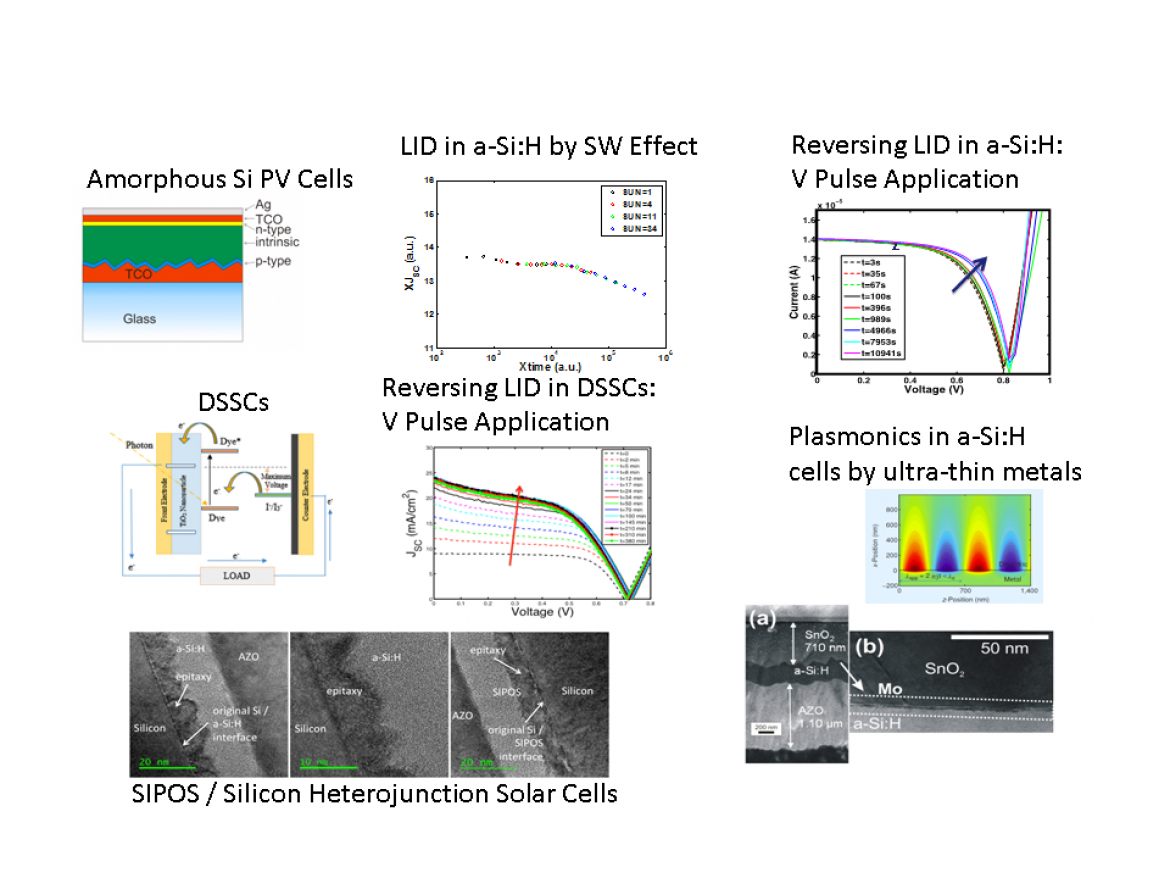
Team: Salvatore Lombardo, Andrea Scuto, Luca Valenti, Ting Ting Han, Stefania Privitera (CNR-IMM, Catania)
The Staebler and Wronski light soaking effect is a well known light induced degradation (LID) effect mainly attributed to dangling bond defects whose density under light illumination increases. To mitigate such undesired effect and so, to render the a-Si:H PV technology commercially viable, the established solution is the stabilization of the defect concentration in the a-Si:H materials by extended light soaking.
We have shown that the application of a reverse bias to a-Si:H and amorphous Si / microcrystalline Si tandem solar cells not only recovers its light- induced degradation caused by the Staebler-Wronski effect, but, on the contrary, it produces an improvement of the overall solar cell performance. We have investigated the role of electric field intensity, illumination, substrate type and temperature, on doped single layers of a-Si:H, a-Si:H solar cells, and micromorph solar cells, providing novel information on the improvement kinetics and on the possible causes.
Light trapping for thin film solar cells is a crucial objective of current research in photovoltaics, to minimize the amount of semiconductor material used to fabricate the solar modules, with corresponding improvements of performance and costs. Plasmonics provides a technique to obtain light trapping. One approach uses surface plasmon polariton (SPP) modes confined to metal / semiconductor interface. In particular, we have studied the effect of ultra-thin Molibdenum films deposited on SnO2:F TCO layers in a-Si:H solar cells deposited on these substrates in superstrate configuration. We find that under suitable Mo sputtering conditions the cells show better JSC, VOC, and Rseries compared to reference samples without Mo deposition. We believe such improvements are due to SPP modes at the Mo / TCO interface which provide light trapping and improve light absorption and conversion.
The Heterostructure with Intrinsic Thin layer solar cell, so called HIT, is one of most promising silicon based technology to enhance the cost/efficiency factor. This is attributed to the combined effect of the lower thermal budget and the increase of the open circuit voltage, thanks to the heterojunction barrier that decreases the minority current. Many improvements have allowed HIT solar cells to reach the record efficiency of 24.7%.
At IMM we are exploring novel types of heterojunctions and in particular the SIPOS / Si. First results are quite promising and further research is ongoing.
Dye-sensitized solar cells (DSSCs) have been studied extensively and have attracted much attention in recent years because of its low cost and high efficiency, making them very promising for different photovoltaic applications.
We have shown that the application of a stress bias larger than -1 V not only can recover its light-induced degradation but it can also produce an improvement of the performance, especially of the series resistance, of the short circuit current, and of the overall power conversion efficiency. Various experiments were performed, as a function of stress bias voltage, electrolyte type, illumination and temperature conditions. The results may be explained by an improvement of the short circuit current, series resistance and fill factor due to an improvement of the carrier lifetime. Further analyses are running to understand the effect.
Research Projects
PON02_00355_3391233 “Tecnologies for ENERGy and energETIC efficiency (ENERGETIC)”, PON “Ricerca e Competitività 2007-2013”
PON01_01725 “New Photovoltaic Technologies for Building Integrated Smart Systems”, PON “Ricerca e Competitività 2007-2013”
ENIAC JTU Project N. 270722: “ENERGY FOR A GREEN SOCIETY: FROM SUSTAINABLE HARVESTING TO SMART DISTRIBUTION. EQUIPMENTS, MATERIALS, DESIGN SOLUTIONS AND THEIR APPLICATIONS (ERG)”
Selected Papers
Scuto, A., Lombardo, S., Di Marco, G., Calogero, G., Citro, I., Principato, F., & Chiappara, C. Improvement of DSSC performance by voltage stress application, IEEE-IRPS, Pasadena, CA, 2016
Scuto, A., Foti, M., Gerardi, C., Battaglia, A., & Lombardo, S. Improvement of solar cell performance and reversibility of ageing effects in hydrogenated amorphous silicon solar cells under illumination and electric field stress: role of TCO and substrate, IEEE-IRPS, Pasadena, CA, 2016
Scuto, A; Valenti, L; Pierro, S; Foti, M; Gerardi, C; Battaglia, A; Lombardo, S, Role of electric field and electrode material on the improvement of the ageing effects in hydrogenated amorphous silicon solar cells, SOLAR ENERGY MATERIALS AND SOLAR CELLS, 2015, 141, , 203, 209, 10.1016/j.solmat.2015.05.040
Di Marco, G; Calogero, G; Di Carlo, A; Lombardo, S; Palmisano, L; Isabella, O, Thin-Film Photovoltaics 2014, INTERNATIONAL JOURNAL OF PHOTOENERGY, 2015, 10.1155/2015/936458
Pierro, S; Scuto, A; Valenti, L; Foti, M; Battaglia, A; Mannino, G; Gerardi, C; Crupi, F; Lombardo, S, Measurements and Simulations on the Mechanisms of Efficiency Losses in HIT Solar Cells, INTERNATIONAL JOURNAL OF PHOTOENERGY, 2015, 10.1155/2015/515767
Foti, M; Tringali, C; Battaglia, A; Sparta, N; Lombardo, S; Gerardi, C, Efficient flexible thin film silicon module on plastics for indoor energy harvesting, SOLAR ENERGY MATERIALS AND SOLAR CELLS, 2014, 130, 490, 494, 10.1016/j.solmat.2014.07.048
Lombardo, S; Tringali, C; Cannella, G; Battaglia, A; Foti, M; Costa, N; Principato, F; Gerardi, C, Plasmonic effects of ultra-thin Mo films on hydrogenated amorphous Si photovoltaic cells, APPLIED PHYSICS LETTERS, 2012, 101, 12, 10.1063/1.4753936
Cannella, G; Principato, F; Foti, M; Di Marco, S; Grasso, A; Lombardo, S, Carrier transport mechanism in the SnO2:F/p-type a-Si:H heterojunction, JOURNAL OF APPLIED PHYSICS, 2011, 110, 2, 10.1063/1.3606408

